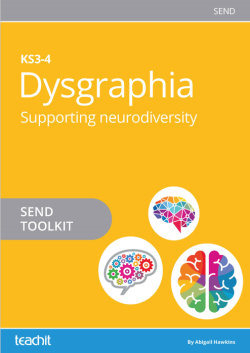Dysgraphia toolkit

A practical toolkit for supporting students with handwriting difficulties at key stage 3 and key stage 4. Dysgraphia toolkit is intended to help young people develop the fine motor skills they may be lacking and offers a full dysgraphia intervention programme targeting specific areas of need.
Note: Dysgraphia toolkit is a digital download, but it is part of our SEND collection and is not included in a Premium subscription.
What’s included?
This 71-page downloadable toolkit includes:
- information about neurodiversity, the strengths of neurodivergent people and some of the challenges they face
- information about dysgraphia and the difficulties in obtaining a dysgraphia diagnosis
- a CPD PowerPoint for staff training, parents’ evenings and senior leadership meetings
- handwriting assessment tools for you to monitor and record students’ specific difficulties
- display resources on writing posture and pen grip
- general classroom strategies, including whole-class warm-ups
- activity ideas and games for practising visual motor skills and fine motor skills
- letter tracing worksheets and cursive writing patterns worksheets
How does it support dysgraphic students?
Dysgraphia toolkit offers time-effective and straightforward ways of diagnosing and supporting dysgraphia in teens. It suggests warm-ups and motor skill activities that are helpful not just for teaching students with dysgraphia but for teaching all young people, and it presents simple ways of supporting dysgraphia in the classroom, without the need for special equipment – although examples of assistive technology are suggested where appropriate.
The intervention programme that it proposes does not need to be followed systematically and can be dipped into by subject teachers and teaching assistants in the mainstream classroom.
The toolkit presents arguments for and against print and joined/cursive writing and recommends that at secondary school students should not be required to adopt one or the other as long as their handwriting is legible and pain-free. It outlines the additional challenges faced by left-handed students and suggests specific support strategies.
Finally, it includes editable handwriting worksheets that can be adapted for any age group and printable handwriting practice sheets for older students.
About the writer
Dysgraphia toolkit was written by Abigail Hawkins, who runs SENDCO Solutions, an SEN consultancy, and SENsible SENCO CIC, a not-for-profit networking support group. She has been a SENDCo for over 25 years and has taught a multitude of subjects across all phases, from two-year-olds to adults. Abigail works with software companies developing supportive software for SEN and safeguarding purposes, has developed and delivers a teaching assistant apprenticeship programme. She has authored several books on SEN and exclusions, and runs a support network for over 10,000 SENDCos.
Abigail has a no-nonsense, practical approach to SEN issues faced by schools, believing that many high-incidence needs can be met in the classroom with basic teaching tweaks.
What’s inside?
- Introduction
- What is neurodiversity?
- What is dysgraphia?
- Classroom strategies
- Case studies
- A support framework
- Visual motor skills
- Manipulation
- Formation
- Organisation
- Technology
- An intervention programme
- Visual motor skills
- Gross motor skills
- Fine motor skills
- Letter formation
- Formation of words
- Organisation
- Technology
- Glossary
- References
- Further support
This toolkit is part of our ‘Supporting neurodiversity’ series – a new collection for teaching neurodiverse students and supporting young people with specific learning difficulties (SpLD). As well as dysgraphia, the series includes:
They form part of a wider SEND collection which also includes:
For resources to support students with Tourette Syndrome, see the resource collection from our partner Tourettes Action.
You might also like Abigail's article on Effective strategies to support handwriting in the mainstream secondary classroom.
Note: Dysgraphia toolkit is a digital download, but it is part of our SEND collection and is not included in a Premium subscription.
An extract from the 'What is dysgraphia?' section:
Dysgraphia (from the Greek, ‘dys’ meaning ‘impaired or difficulty’ and ‘graphia’ meaning ‘writing by hand’) is a term that is not commonly heard. We usually refer to children (and certain adult professionals) as having messy handwriting. Unlike with dyslexia and its cousin dyscalculia, there is relatively little research into dysgraphia in its own right. Since it is often found alongside other neurodiversities, once one of those is identified and labelled then the search for an underlying cause of handwriting difficulties is halted or the other neurodiversity used as the reason.
Dysgraphia is associated with a specific learning difficulty in producing writing. The writer has severe difficulty in producing handwriting that is legible and written at an age-appropriate speed. The Diagnostic and Statistical Manual of Mental Disorders (latest edition: DSM-5-TR) is commonly used to define special educational needs and disabilities. It lists three types of impairment with respect to ‘specific learning disorder’: in reading, in written expression and in mathematics. In an earlier edition of the manual (DSM-IV), dysgraphia as ‘a disorder of written expression’ is characterised by ‘writing skills […] that fall substantially below those expected given the person’s chronological age, measured intelligence, and age-appropriate education’. There is a distinct lack of clarity as to whether this is just the physical motor skills of writing (a traditional interpretation) or whether it includes the orthographical skill of spelling.
All reviews
Have you used this resource?
Review this resource03/02/2023
